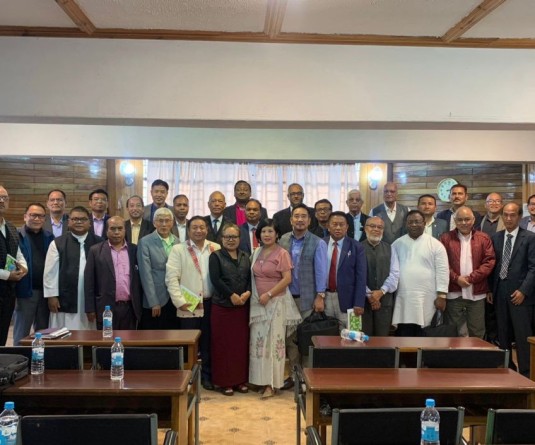
G Gwangphun
Social Research Activist
The Indo-Naga political conflict is on India’s rights verses Nagas’ rights over the land of the Nagas. Two rights are contending for the truth to be revealed. The talk is not for negotiating the rights or compromising the wrong. Rights cannot be negotiated neither the wrong. The talk is to hammer out the right from the wrong. The talk must be based on humanitarian moral conscience. All about the talk is the claim of Nagas’ land as India. Nagas are resisting the claim.
Analysed that India is applying offensive politics and Nagas are applying defensive and resistance politics. The solution is not what India offers. India cannot buy the land of the Nagas even after dividing it into pieces. In reality, sovereignty cannot be shared but recognized and respected. There can be joint mutual politics of sharing powers between the two entities. Political relation and development policies can be mutually established. All that has been projected in the frame-work agreement are borne of Indian bargaining politics since the time of 9 Points agreement of 1947, to 16 Points Agreement of 1960, Cease fire Agreement of 1964, to Shillong Accord of 1975 and Ceasefire of 1997 till date for bargaining talk with the Nagas. The present bargaining is at stake on flag and constitution. Indian or Naga identity (flag) cannot be negotiated. So also national principle (constitution).
India will be committing a fatal crime against humanity if solution is imposed at the behest of the apparent Naga public; CSOs based in Nagaland only. Human rights; the moral principle of humanity must be the guiding conscience of both Nagas and India in sorting out the truth in clear tone and picture. Democracy inspires that sovereignty lies with the people. The 99.9 % Naga plebiscite declaration of 1951 is the democratic sovereign rights of the Naga people. No party can impose or insist on accepting wrong solution to be right.
The case of Nagas’ politic has been suppressed by Indian military politic since March 25th 1955 when killing the Nagas to finish the Nagas’ politics was the inspired politics of Indian politicians. It was the policy of the British India to nib the Naga Resistance Movement in the bud that India has copied to treat the Nagas of today. Now the accumulation of all the account of Naga resistance against Indian occupational politics has been on stage for final countdown. Nagas’ case has to be finished by force is obvious intention of India and India can do it. But it is not right. India doesn’t recognize or accept the Nagas as a nation but a Naga tribe of India. The fact is revealed in the given state of Nagaland. Defined that, Nagas’ struggle is to stand as a free Nation among the nations of the world. The Indo-Naga talk is not for giving or taking anything from both the parties. It is a withdrawal of Indian occupational force and realization of Naga nationhood. Giving a state to Nagaland was meant to stop the Nagas freedom struggle. India called it a cessation movement. Nagas called it a resistance movement. India’s intended talk point is to give economic packages for the Nagas. Whereas Nagas’ talk point is for Naga Nationhood to be realized. India claims the ownership of Nagaland as Indian state. Many Naga-Indian Politicians opted for economic packages are forfeiting the Nagas’ freedom struggle with an appeasement assurance that Flag and constitution can be pursued later. Whatever Solution given must be accepted. Here many Naga publics are made to confuse. But the truth is covered by appeasing the Nagas with dreamy assurance as India did it on the 13th Point of the 16 Points Agreement. Here both the morality of India and Nagas is questioned.
Nagas are not Indian verses Nagas are Indian is the defining politics in conflict in clear view. The controversy is on accepting or not accepting either of the identity. The supposed solution from India is based on economic packages and enhancing of administrative power for the Nagas. Whereas Nagas’ issue is not of getting power or money from India. It is of mutual respect and recognition of different entities under democratic values to be processed by both the parties. The frame-work agreement in letter and in spirit is meant to sort out the modality for final settlement of the differences between the two parties. Each entity has its own flag and constitution. Both have rights to own its own properties. Solution without its flag and constitution is not the solution for India if India were in Nagas’ position. India will not accept it. So also Nagas. Nagas cannot forfeit their rights to self determination for the sake of getting a short term gain or promising hope. It appears that many Nagas are convinced to conclude that the present offer of India to be the best solution or only way out solution. It implies that Nagas will be made Indian. Its result will turn out to be a bitter solution for the Nagas. The 16 Points Agreement that divides the Nagas and Shillong Accord that destroyed the Nagas will reappear in a greater measure in the form of the Frame-work Agreement as Delhi Accord. The natural law of compensation demands that gain in a given direction necessitates loss in its opposite direction. The loss of Nagas will be the gain of India. Vice versa. Either one for each. Accepting the truth is the solution. Here both are not at lost but gained. Both will be exalted to height of humanity.




